Who Doesn’t Love a (Penguin) Parade?
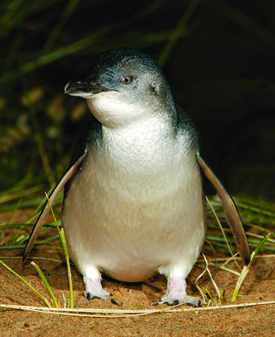
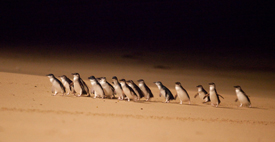
It’s not just 5-year old children who get excited by the sight of penguins; on no, penguins have been “all the rage” in movies and on television these past few years, delighting all ages. These magnificent, peaceful flightless birds are a key indicator to the health and environment rating of our planet. But I’ll get to my public service announcement a little later.
I recently visited the great city of Melbourne, Australia, and took a trip out to Phillip Island to see the Little Penguins (Eudyptula minor). Unlike the traditional tuxedo sported by their kin, these fellas, and dames, sashay in a blue and white plumage. Standing a mere foot high, the Little Penguin grows to between 30 and 33 cm (12 to 13 inches) tall and usually weighs about 1.5 kilograms on average (3.3 pounds). What these little birds lack in stature, they sure make up in noise; speaking to their mates, as if telling them to hurry up and get home! It was quite an experience watching the dynamic interactions between the penguins, both in one on one conversation and in larger groups of 30, 60 or more.
The southwest end of the island, where the penguins reside, is a serene, secluded, lush green wonderland. In the morning, an hour or two before sunrise, they head out to sea for a full day of fishing. At sunset, they come home in groups. As you look out over the Bass Strait, your eyes focus on these huge black masses floating on the water. These black patches across the dark ocean are the penguins, swimming tightly together for protection from predators. When they hit the beach, the show starts, and for the next 2 hours young and old alike are delighted and fascinated. Every year, upwards of 500,000 people visit this nature preserve to view the penguins march home in their grand parade as they swim home, climb the steep cliffs and head to their burrows.
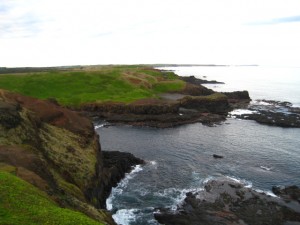
Since the 1920’s residents and visitors have been flocking to witness this spectacle. And back during that time, that weren’t many laws or rules protecting the little guys. If you look back in some of the history books, you can see masses of people gathered down on the beach, sitting there waiting for the penguins, close enough to touch (and I’m just guessing, some were touched). That, coupled with predation by Leopard Seals at sea, and by foxes, ferrets, Pacific Gulls and White Sea-eagles on land, and the scores of holiday tourists, commercial fishing and plastic pollution; well, it put a lot of pressure on the penguin colony.
There were 10 penguin colonies; now just one colony remains. The colony is estimated to be at approximately 70,000 penguins, 1/3 of the total penguin population in the state of Victoria. In the Penguin Parade area, the counts fluctuate between 600-800 birds coming ashore.
Can you imagine if someone came into your home and started rearranging your things, or if someone came into your neighborhood and began laying down train tracks or constructing housing in the middle of the street? That’s kind of what we have done and continue to do to some of the most unprotected, pristine habitats on this planet. We overfish, we clear cut forests, and we over fertilize our fields. The time is ripe for placing an emphasis on resource management. And sticking to it. That’s what Phillip Island has done.
Seeing the great need to reverse course to protect this last remaining colony of penguins, the island has undergone a dramatic transformation. Phillip Island Nature Park manages and protects 1,805 hectares of land. Caretakers started building penguin burrows to attract the penguins to nest. And they started a program to remove all of the holiday houses.
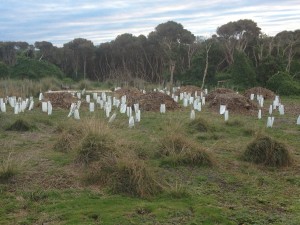
In 1985 the Victorian Government initiated a program to purchase and remove all of the holiday houses on the Summerland Peninsula where the penguins reside (the Penguin Protection Plan). The park rangers then went to work building penguin housing, and replanting native vegetation to rehabilitate the area. To put into perspective how long a program like this can take, last year the final holiday house was razed. But this program is working, as the penguins are moving in to these manmade housing units and they appear to be a healthy and thriving.
This penguin colony is thriving for a number of reasons.
One, you can no longer go down onto the beach for an up close and personal experience with the penguin. A grandstand of bleachers has been constructed. You can get a front row there or splurge for the VIP pass. Oh yes, there is a VIP pass to view the penguins. Two, flash photography is not allowed; photography or video of any kind is not allowed. And when you think about it, this is actually a great rule because you aren’t focused on getting the “money shot”. You actually can immerse yourself into the experience and you’re enriching your mind so much more than if you were constantly trying to shoot film. You can actually follow the penguins home to their burrows. The wide, lighted (red spectrum) boardwalks follow some of their main paths. At certain points, the birds are about 2-3 feet (~1 metre) away, so you can get a real good view of their behavior. And the third reason the Little Penguins are rebounding is due to the dedicated staff and park rangers of Phillip Island. The funding that comes from tour ticket sales furthers research and protection efforts of the Little Penguins.
But it’s not all rosy for our well-dressed feathered friend. Certain species of Antarctica penguins have declined by 80% since 1975. The debate continues as to whether and how many of the 17-20 species of penguins are endangered. In 2010, the U.S. Fish and Wildlife Service listed the Humboldt, yellow-eyed, white-flippered, Fiordland crested, erect-crested and African penguins as threatened. And in the next year, the southern rockhoppers in Australia and New Zealand were also listed. But the emperor penguins and chinstraps, still need help. Endangered or threatened, they definitely warrant protection. Oil spills – oil ingested by the penguins as they try to preen their feathers, or ending up in the egg of their offspring, chunks of icebergs breaking off and preventing access to food, or commercial fishing boats actually hitting penguins and causing death – it’s not easy being a penguin.
Food chains are pretty well understood. Scientists are studying and believe that microbial and krill populations have declined in the Polar Regions. So that affects the penguin population, which in turn can affect the larger sea mammals. We have to start measuring the environemtal impact – and find ways to halt the food source disappearance and habitat destruction…and stop climate change in its tracks – not only for penguins, for all animal and plant species. No small feat, right? But we have to start somewhere. Little changes made today can have a big impact tomorrow. So what will you do to ensure penguins continue to march in their parade?
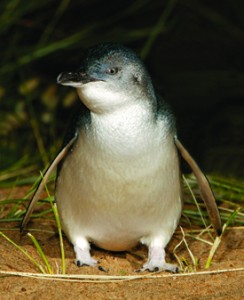
Photos of penguins used in this post were taken from Phillip Island Nature Parks Australia, http://www.penguins.org.au.
If you’re ever in the Melbourne area and thinking of visiting Phillip Island, I highly recommend booking a tour with the Little Penguin Bus to get out to the island.
 Follow
Follow
1 thought on “Who Doesn’t Love a (Penguin) Parade?”
Comments are closed.